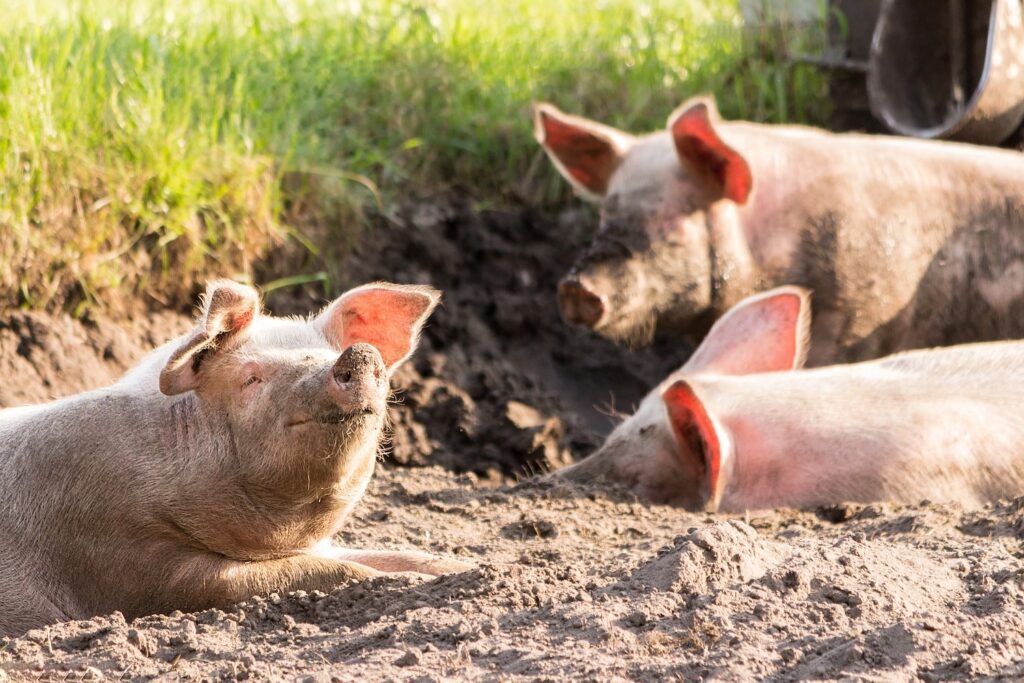Heat stress in pigs: how big of an issue will it be this year?
25th June 2021
Although we’ve only just started to see the sun, heat stress can prove a problem even when the sun is not out. Lallemand’s Hannah Elliott explains the risk factors, signs and how to minimise the impact through nutritional management.
Whether it is bright and sunny or dull and wet, warmer temperatures and humidity levels can create stressful conditions for pigs, particularly larger animals such as finishers and sows. This can lead to lower feed intakes, gut health issues and slower growth rates.
Hannah Elliott, monogastric sales and technical support at Lallemand Animal Nutrition (pictured below), outlines the risk factors and signs of heat stress to look out for, and explains how nutritional management can minimise the impact during the finishing stage.
Weather conditions
The risk of heat stress increases at around 18°C and above. Hot, sunny weather is obviously a key factor, but Ms Elliott says it is important to remember there is also a considerable risk when there is no direct sunlight.
“When increasing temperatures are combined with rain, as has been the case this year, humidity raises the risk of heat stress, which could also be termed environmental stress. As the air temperature increases, so does its capacity to hold moisture, which makes it feel even warmer and ‘close’ like the atmosphere in a rainforest.
“We know that pigs have to pant to get rid of heat, as they don’t sweat. When they breathe out into warm air which is already full of moisture, there is less heat exchange as effective evaporation needs a dry environment, so pigs can struggle to reduce their temperature as easily.”
Signs of heat stress
A temperature sensor is useful to have both inside and outside the building, and it is important to know what to look out for. Key signs of heat stress in pigs include:
- Panting and higher heart rate
- Unusual feeding behaviour such as less frequent feeding and gorging (leading to bloat)
- Reduced overall feed intake, which will also be reflected in the growth curve
- Increasing water consumption
- Skin can look drier and paler if pigs become dehydrated
- Inaction or wanting to lie down.
Management
Preparation and early preventative action are key to managing the risk of heat stress, Ms Elliott emphasises.
To keep pigs cooler outdoors, it helps to make sure that arks or tents are properly insulated, or white in colour to reflect the heat, and that adequate shade is provided. Clean fresh drinking water is essential and mud wallows can be created to keep pigs cool and provide a form of sunscreen. It helps if it’s windy, as the airflow creates a cooling effect.
There is a greater level of control in indoor herds, however adequate ventilation is crucial and systems must be kept in good working order. Automated systems will adjust air inlets and fans according to conditions. Evaporative cooling/misting systems or sprinklers can also help. Again, make sure pigs have a constant supply of cool, clean water, maintaining adequate pressure during peak demand periods.
Nutritional factors
If there is a prolonged hot period forecast, increasing the energy content of feed slightly and feeding less could be an option, says Ms Elliott. “You then need to make sure dietary vitamins and minerals are adequate in relation to the amount of feed pigs consume, to maintain electrolyte balance – which is important if pigs are becoming dehydrated.”
If pigs are showing signs of stress, check the diet is providing enough antioxidants, to combat any oxidative stress that might occur. “Pigs will divert energy towards tackling an oxidative stress problem, rather than growth. If you suspect it, seek a nutritionist’s advice and have a look at the ration composition and feed intakes,” says Ms Elliott.
Producers sometimes reduce dietary fibre levels when it gets hot, as fibre fermentation in the colon releases heat, but they should avoid drastic changes, Ms Elliott cautions. Fibre has a key role in gut health and decreasing it too much could increase the risk of gastric ulcers and other welfare or performance issues.
Liquid feeding
In liquid feeding systems, there are further measures to take to help manage heat stress, as the feed is more likely to go off and lose quality in warm weather compared to dry feed:
- Check the quality of liquid feed every time you feed it, looking out for any bubbling or unusual smells which suggest undesirable fermentation
- Try feeding earlier and later in the day when it is cooler. This applies to dry feed too. If liquid feed is left to stagnate for a few hours before pigs eat it, not only could it potentially be wasted but it also encourages proliferation of pathogens which can build up over time in the trough
- Therefore, always clean out any residual feed left in the trough; it is worth the effort
- Summer is a sensible time to consider investing in specific additives to reduce pH and help control microorganisms in the feed. They can create a more acidic environment in the feed which is inhospitable to pathogenic bacteria and favourable to beneficial bacteria like Lactobacilli, helping to preserve the feed and maintain gut health
- Start deploying any interventions such as additives before temperatures get too high. Pathogenic bacteria are much more difficult to get rid of once populations have been sustained in feed tanks for a while.
Enterotoxaemia
Be aware of the risk of enterotoxaemia, characterised by bloat and sudden death. Warmer weather can exacerbate the problem in liquid fed pigs, particularly if eating habits are more erratic.
“When there are higher levels of pathogenic bacteria in the feed, the bacteria may be consuming lysine and other amino acids in the diets themselves,” Ms Elliott explains. “This means valuable nutrients are not getting to the pig and, in the worst case, the resulting biogenic amines produced by the bacteria can cause several health and welfare issues.”


